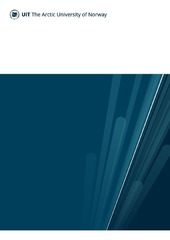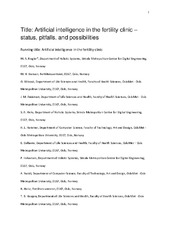Institutt for informatikk: Nye registreringer
Viser treff 341-360 av 769
-
Information and communication technology-based interventions for chronic diseases consultation: Scoping review
(Journal article; Tidsskriftartikkel; Peer reviewed, 2022-04-29)Background: Medical consultations are often critical meetings between patients and health personnel to provide treatment, health-management advice, and exchange of information, especially for people living with chronic diseases. The adoption of patient-operated Information and Communication Technologies (ICTs) allows the patients to actively participate in their consultation and treatment. The ... -
On Optimizing Transaction Fees in Bitcoin using AI: Investigation on Miners Inclusion Pattern
(Journal article; Tidsskriftartikkel; Peer reviewed, 2022-04-09)The transaction-rate bottleneck built into popular proof-of-work-based cryptocurrencies, like Bitcoin and Ethereum, leads to fee markets where transactions are included according to a first-price auction for block space. Many attempts have been made to adjust and predict the fee volatility, but even well-formed transactions sometimes experience unexpected delays and evictions unless a substantial ... -
Comparative validation of multi-instance instrument segmentation in endoscopy: Results of the ROBUST-MIS 2019 challenge
(Journal article; Tidsskriftartikkel; Peer reviewed, 2020-11-28)Intraoperative tracking of laparoscopic instruments is often a prerequisite for computer and roboticassisted interventions. While numerous methods for detecting, segmenting and tracking of medical instruments based on endoscopic video images have been proposed in the literature, key limitations remain to be addressed: Firstly, robustness, that is, the reliable performance of state-of-the-art methods ... -
A Health-Energy Nexus Perspective for Virtual Power Plants: Power Systems Resiliency and Pandemic Uncertainty Challenges
(Chapter; Bokkapittel, 2022-01-01)This chapter introduces and discusses a novel “health-energy nexus under pandemic uncertainty” concept that arises as a consequence of the current pandemic that we are experiencing worldwide. In light of the pandemic implications on the power and energy systems, we discuss how the global health conditions are tightly connected with the energy consumption needs and how the two areas closely interact ... -
Meta-learning with implicit gradients in a few-shot setting for medical image segmentation
(Journal article; Tidsskriftartikkel; Peer reviewed, 2022-01-12)Widely used traditional supervised deep learning methods require a large number of training samples but often fail to generalize on unseen datasets. Therefore, a more general application of any trained model is quite limited for medical imaging for clinical practice. Using separately trained models for each unique lesion category or a unique patient population will require sufficiently large curated ... -
Aika: A Distributed Edge System For Machine Learning Inference. Detecting and defending against abnormal behavior in untrusted edge environments
(Master thesis; Mastergradsoppgave, 2021-12-14)The edge computing paradigm has recently started to gain a lot of momentum. The field of Artificial Intelligence (AI) has also grown in recent years, and there is currently ongoing research that investigates how AI can be applied to numerous of different fields. This includes the edge computing domain. In Norway, there is currently ongoing research being conducted that investigates how the confluence ... -
Dataset of Consumer-Based Activity Trackers as a Tool for Physical Activity Monitoring in Epidemiological Studies During the COVID-19 Pandemic
(Journal article; Tidsskriftartikkel; Peer reviewed, 2022-03-01)Physical activity (PA) data were downloaded from 113 participants who owned a Garmin or Fitbit activity tracker in 2019 and 2020. Upon participant authorization, data were automatically downloaded from the Garmin and Fitbit cloud storages. The mSpider tool, a solution for automatic and continuous data extraction from activity tracker providers, were used to download participant data. Available ... -
The variability of physical match demands in elite women's football
(Journal article; Tidsskriftartikkel; Peer reviewed, 2022-01-21)Peak locomotor demands are considered as key metrics for conditioning drills prescription and training monitoring. However, research in female football has focused on absolute values when reporting match demands, leading to sparse information being provided regarding the degrees of variability of such metrics. Thus, the aims of this study were to investigate the sources of variability of match ... -
Inverse and efficiency of heat transfer convex fin with multiple nonlinearities
(Journal article; Tidsskriftartikkel; Peer reviewed, 2021-07-22)In this article, we first propose the novel semi-analytical technique—modified Adomian decomposition method (MADM)—for a closed-form solution of the nonlinear heat transfer equation of convex profile with singularity where all thermal parameters are functions of temperature. The longitudinal convex fin is subjected to different boiling regimes, which are defined by particular values of n (power ... -
Label-free non-invasive classification of rice seeds using optical coherence tomography assisted with deep neural network
(Journal article; Tidsskriftartikkel; Peer reviewed, 2021-01-01)Identification of the seed varieties is essential in the quality control and high yield crop growth. The existing methods of varietal identification rely primarily on visual examination and DNA fingerprinting. Although the pattern of DNA fingerprinting allows precise classification of seed varieties but fraught with challenges such as low rate of polymorphism amongst closely related species, destructive ... -
Employee-driven digital innovation: A systematic review and a research agenda
(Journal article; Tidsskriftartikkel; Peer reviewed, 2022-02-01)As the digital shift in society affects both private and public organizations, the role of digital innovation is critical if digital transformations are to succeed. Research has developed models to explain how digital innovation affects organizations and societies. During the last ten years, employee-driven innovation has emerged as a new approach to explain innovation. Through this systematic ... -
Real-Time Polyp Detection, Localization and Segmentation in Colonoscopy Using Deep Learning
(Journal article; Tidsskriftartikkel; Peer reviewed, 2021-03-04)Computer-aided detection, localization, and segmentation methods can help improve colonoscopy procedures. Even though many methods have been built to tackle automatic detection and segmentation of polyps, benchmarking of state-of-the-art methods still remains an open problem. This is due to the increasing number of researched computer vision methods that can be applied to polyp datasets. ... -
Topic-based Video Analysis: A Survey
(Journal article; Tidsskriftartikkel; Peer reviewed, 2021-07-13)Manual processing of a large volume of video data captured through closed-circuit television is challenging due to various reasons. First, manual analysis is highly time-consuming. Moreover, as surveillance videos are recorded in dynamic conditions such as in the presence of camera motion, varying illumination, or occlusion, conventional supervised learning may not work always. Thus, computer ... -
Augmenting SQLite for Local-First Software
(Journal article; Tidsskriftartikkel; Peer reviewed, 2021-07-17)Local-first software aims at both the ability to work offline on local data and the ability to collaborate across multiple devices. CRDTs (conflict-free replicated data types) are abstractions for offline and collaborative work that guarantees strong eventual consistency. RDB (relational database) is a mature and successful computer industry for management of data, and SQLite is an ideal RDB candidate ... -
Next frontiers in energy system modelling: A review on challenges and the state of the art
(Journal article; Tidsskriftartikkel; Peer reviewed, 2022-02-26)Energy Systems Modelling is growing in relevance on providing insights and strategies to plan a carbon-neutral future. The implementation of an effective energy transition plan faces multiple challenges, spanning from the integration of the operations of different energy carriers and sectors to the consideration of multiple spatial and temporal resolutions. In this review, we outline these challenges ... -
Using 3D Convolutional Neural Networks for Real-time Detection of Soccer Events
(Journal article; Tidsskriftartikkel; Peer reviewed, 2021-06)Developing systems for the automatic detection of events in video is a task which has gained attention in many areas including sports. More specifically, event detection for soccer videos has been studied widely in the literature. However, there are still a number of shortcomings in the state-of-the-art such as high latency, making it challenging to operate at the live edge. In this paper, we present ... -
Detection of ground contact times with inertial sensors in elite 100-m sprints under competitive field conditions
(Journal article; Tidsskriftartikkel; Peer reviewed, 2021-11-04)This study describes a method for extracting the stride parameter ground contact time (GCT) from inertial sensor signals in sprinting. Five elite athletes were equipped with inertial measurement units (IMU) on their ankles and performed 34 maximum 50 and 100-m sprints. The GCT of each step was estimated based on features of the recorded IMU signals. Additionally, a photo-electric measurement ... -
MSRF-Net: A Multi-Scale Residual Fusion Network for Biomedical Image Segmentation
(Journal article; Tidsskriftartikkel; Peer reviewed, 2021-12-23)Methods based on convolutional neural networks have improved the performance of biomedical image segmentation. However, most of these methods cannot efficiently segment objects of variable sizes and train on small and biased datasets, which are common for biomedical use cases. While methods exist that incorporate multi-scale fusion approaches to address the challenges arising with variable ... -
Northeast Arctic Cod and Prey Match-Mismatch in a High-Latitude Spring-Bloom System
(Journal article; Tidsskriftartikkel; Peer reviewed, 2021-12-20)By combining an ocean model, a nutrient-phytoplankton-zooplankton-detritus-model and an individual-based model for early life stages of Northeast Arctic cod we systematically investigate food limitations and growth performance for individual cod larvae drifting along the Norwegian coast from spawning grounds toward nursery areas in the Barents Sea. We hypothesize that there is food shortage for ... -
Artificial intelligence in the fertility clinic: status, pitfalls and possibilities
(Journal article; Tidsskriftartikkel; Peer reviewed, 2021-07-29)In recent years, the amount of data produced in the field of ART has increased exponentially. The diversity of data is large, ranging from videos to tabular data. At the same time, artificial intelligence (AI) is progressively used in medical practice and may become a promising tool to improve success rates with ART. AI models may compensate for the lack of objectivity in several critical procedures ...


 English
English norsk
norsk


















